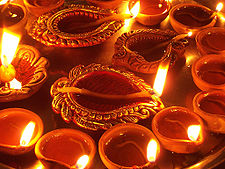- Tihar (festival)
-
For other uses, see Tihar (disambiguation).
Tihar 
Also called Deepawali (दीपावली), Yama Panchak (यम पञ्चक) Observed by Hindus worldwide (with various names and slight variations) Type Religious, Nepali Date New moon day of Kartika, celebrations begin two days prior and end two days after that date 2011 date october 25-28 Celebrations Decorating homes with lights, singing, dancing, gambling etc[citation needed] Observances Prayers and religious rituals Tihar (तिहार) is a five-day Nepalese festival celebrated in late autumn, which comes soon after Dashain. Two of these days incorporates the Hindu festival Deepavali, where one day is celebrated for goddess Laxmi and the other one is celebrated to worship brothers for their long life[1]. However, all ethnic groups celebrate this festival. The festival is celebrated from Trayodashi of Kartik Krishna to Katrik Shukla Dwitiya every year.The name Tihar means the festival of lights, where many candles are lit both inside and outside the houses to make it bright at night. The five-day festival is considered to be of great importance as it shows reverence to not just the humans and the Gods, but also to the animals like crow, cow and dog, who maintain an intense relationship with the humans.
Contents
Kag Puja
The first day of the festival is called Kag Puja or Kag Parva - Worship of Crows.[2] The crows are worshipped by offerings of sweets and dishes on the roof of the houses. The cawing of the crows symbolises sadness and grief in the Hindu mythology, so the devotees offer the crows food to avert grief and deaths in their homes.Tihar in Nepal and Diwali in India represent the divine attachment between Human and other animals and birds in our nature. To strengthen the worship of nature, all these rituals are introduced in Hinduism.
Kukur Puja
[[ The second day is called "Kukur Puja" or "Khicha Puja" ("worship of the dogs") by the Newars.[3] Dog, which is believed to be messenger of Lord Yamaraj, the god of death, is worshiped once a year on this day.[2] People offer garlands, teeka and delicious food to the dogs, and acknowledge the cherished relationship between humans and the dogs.
This day is also observed as Narak Chaturdashi.
Gai Puja and Laxmi Puja
On the morning of the third day is Gai Puja - the cow is sign of prosperity and wealth. In ancient times people benefitted a lot from the cow like its milk, dung even its urine was used for kind of purification. Thus on this day people showed their gratefulness to the cow by garlanding and feeding the cow with the best grass. Houses are cleaned and the doorways and windows are decorated with garlands made of marigolds and chrysanthemums. In the evening Laxmi, the goddess of wealth is thanked for all the benefits that were bestowed on the families by lighting oil lamps or candles on doorways and windows to welcome prosperity and well being. At night the girls enjoy dancing and visiting all the houses of the village with many musical instruments playing a historical game called bhailini(vailini) all night long. They collect money from all the houses by singing and dancing and share the sweets and money amongst themselves.
Gobhardan Puja and Mha: Puja
On the fourth day of Tihar, there are three different known pujas, depending on the people's specific cultural background.[2] Most perform Goru Puja, or Worship of Oxen. People who follow Krishna perform Gobardhan Puja, which is worship towards Cowdung. Cowdung is seen as very useful in Nepal, as in the olden days it was used for everything from light at night (Methane) to polish for the mud floors of traditional houses. The Newar community on the night of this day do Mha: Puja, or Worship of Self. Because this period is also the beginning of Nepal Sambat, or the new year of Nepalese especially commemorated by Newars, it ensures prosperity for the new year.
The third and fourth day of Tihar is especially famous for Deusi and Bhailo, light and fireworks. Deusi and Bhailo are the songs which have only been sung on those Tihar days. Social workers, young and children visit local homes to sing these songs, and in return the home owners give them money, fruit, rice and bread (Selroti, a special type of bread made by rice flour and sugar). The Deusi is mostly sung by the boys while the Bhailo is sung by the girls.
Bhai Tika
The fifth and last day of Tihar is Bhai Tika, a day where sisters put "tika" on foreheads of brothers, to ensure long life, and thank them for the protection they give.[2] When the sisters give the "Tika", the brothers give gifts or money in return. A special garland is made for the brothers out of a flower that wilts after a couple of months, symbolizing the sister's prayer for her brother's long life.
References
External links
Categories:- Nepalese culture
- Festivals in Nepal
- Hindu festivals
Wikimedia Foundation. 2010.

